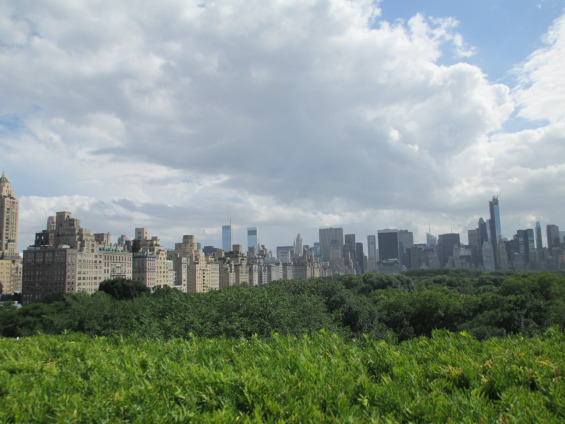Last Friday I made my second-ever visit to the Morgan Library & Museum. The Morgan, which began as the private library of Pierpont Morgan, father of J.P Morgan, is now a complex of buildings that houses rare books and materials, and even includes a performance space. Admission is a bit pricey, but it’s free on Friday nights between 7 and 9 p.m., and when I was there they had a pair of musicians playing in the courtyard, near the café.
The Morgan’s permanent collection is impressive, but I also just love the building. The library portion reminds me of a small scale version of the Beauty and the Beast library, and it even has a (locked) doorway hidden by a bookcase, which a security guard pointed out on my first visit. This time I gleefully noticed an image of a dragon on the fireplace, above where the flames would be. And you could spend an hour just reading the spines on the shelves, not to say anything of the fine pieces of literature and history showcased in the library.
All this is to say that the Morgan is worth a visit at any time, but I especially urge to go now, before April 27, while the exhibit “The Little Prince: A New York Story” is on view. If you haven’t read The Little Prince, go buy a copy and read it, and then go to the exhibit.
The Little Prince, written by French aviator Antoine de Saint-Exupéry and published in the US in 1943 simultaneously in English and French, is one of my favorite books. I have a lot of favorites, but this is one that I’ve read many times. It’s one of the books that grows with you, even though (and maybe because) part of its message is a reminder not to become a grown up. Grown ups, as the book tells us, are very strange, and are preoccupied so much with things that don’t matter that the things that do matter pass them by. Grown ups get caught up in worrying about money, or status, forgetting that, as the fox tells the little prince, “One sees clearly only with the heart. What is essential is invisible to the eye.”
In her book about faith and art, Walking on Water, Madeleine L’Engle refers to one of my favorite parts of The Little Princewhen discussing how children, when creating art, are free from self-consciousness. She says, “They don’t worry that they may not be as good as Di Chirico or Bracque; they know intuitively that it is folly to make comparisons, and they go ahead and say what they want to say. What looks like a hat to a grownup may, to the child artist, be an elephant inside a boa constrictor.” Like Saint-Exupéry, I’m fairly confident that if I show someone his picture of a boa that has eaten an elephant and he or she knows exactly what it is, we will be able to talk about the things that are really important.
The Morgan exhibit highlights that while Saint-Exupéry wrote about the child’s ability to see to the heart of things and to understand more than grown ups, he was not content to toss his words and pictures on a piece of paper and trust to his readers to understand his message. His first draft of The Little Prince was over twice as long as the 14,000 word final book, and the exhibit takes us through some of the passages and images which existed only in early versions. We follow the narrative, seeing as Saint-Exupéry writes and edits and streamlines and focuses his message until he’s honed it into the story loved around the world. Did you know The Little Prince has been translated into more languages than any other work of fiction? I didn’t, until Friday.
There are interesting bits about Saint-Exupéry and the book throughout the exhibit, from the writing in the book while Saint-Exupéry lived in New York City, to his subsequent disappearance after an aircraft mission in the south of France the year after the book was published. The biographical details are fascinating, especially when seen in context with the story’s message of loss and longing, but it was the manuscript that really drew me. How hard he must have worked to choose those 14,000 perfect words!
If you can, visit the Morgan in the next three months and see the exhibit. Be sure to notice the beautiful blue walls of the exhibition room, with their simple recreations of images from the book—including the one that Saint-Exupéry calls the “loveliest and saddest landscape in the world.” After you go, I promise you that you’ll want to read the book again.
Have you been to the Morgan? Or will The Little Prince convince you to go?
Leave a Reply
© 2025 Noted in NYC
Theme by Anders Noren — Up ↑

0 Comments
1 Pingback